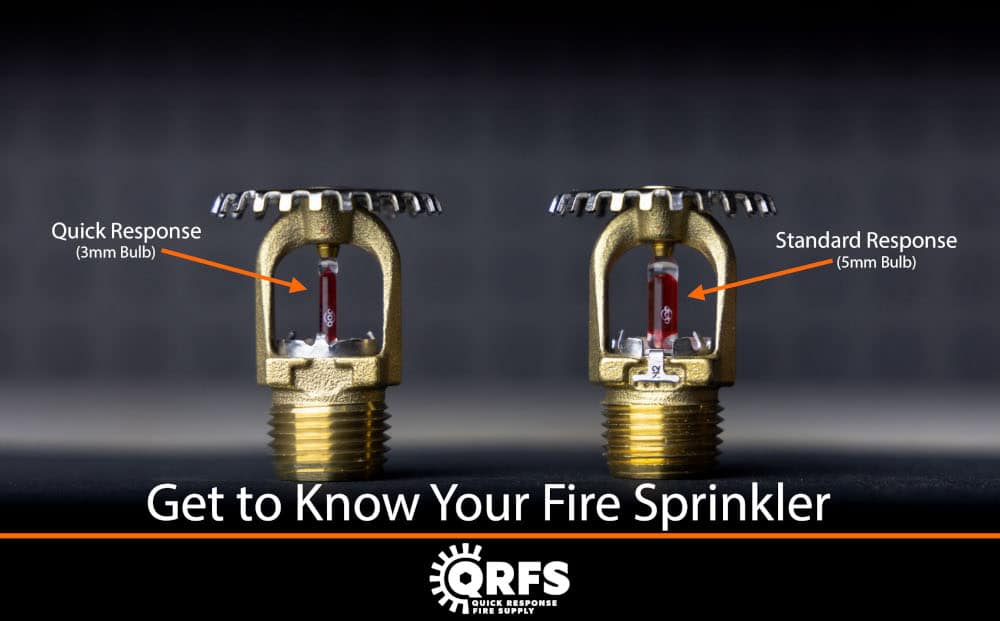Use cases, listings, and approvals can change rated “thermal sensitivity”
Each fire sprinkler is supposed to have a specific thermal sensitivity, aka response type, revealed by its unique sprinkler identification number (SIN). Sprinklers are standard response or fast response, the latter a category that includes residential fast response and commercial quick response heads, plus other models.
However, some individual sprinklers are labeled “quick and standard response,” a characteristic that you might logically assume shouldn’t change, given that all examples of the model are physically identical.
Regardless, fire sprinklers can be considered quick or standard response based on where they are installed, what they are, and how major listing and approval agencies—notably, UL and FM Global—rate them. Here’s a rundown:
- A review of fire sprinkler response types
- The importance of thermal sensitivity
- The SIN specifies the physical design of a sprinkler’s thermal element
- Two major scenarios where thermal sensitivity ratings change:

A review of fire sprinkler response types
In addition to having a specific activation temperature, fire sprinklers have a response type, technically known as “thermal sensitivity:”
- The activation temperature is the temperature at which the sprinkler goes off—its bulb shatters or its solder melts to release the water.
- The response type (thermal sensitivity) determines how fast it goes off at that activation temperature.
Here are the major thermal-sensitivity categories:
- Standard response sprinklers have a ‘regular’ sensitivity—a response time index (RTI) of 80 or more (meters-second)1/2. Sprinklers like this are used in many commercial applications where property protection is a priority, in addition to saving lives.
- Fast response sprinklers: these go off somewhat faster than standard response models. They have a response time index (RTI) of 50 or fewer (meters-second)1/2. They include:
- Residential fast-response sprinklers: All residential sprinklers (used in homes, many apartments, etc.) are fast-response, prioritizing life safety.
- Quick-response sprinklers are a type of fast-response sprinkler that’s essentially a commercial version of residential sprinklers (with a slightly different spray pattern).
- Early suppression, fast response (ESFR) sprinklers go off quickly and directly suppress a fire in high-challenge storage environments.
You can spot standard vs. fast/quick response bulb-type sprinklers based on the thickness of their heat-sensitive glass bulb. A thinner bulb means it is a fast/quick response model and will break a little faster:
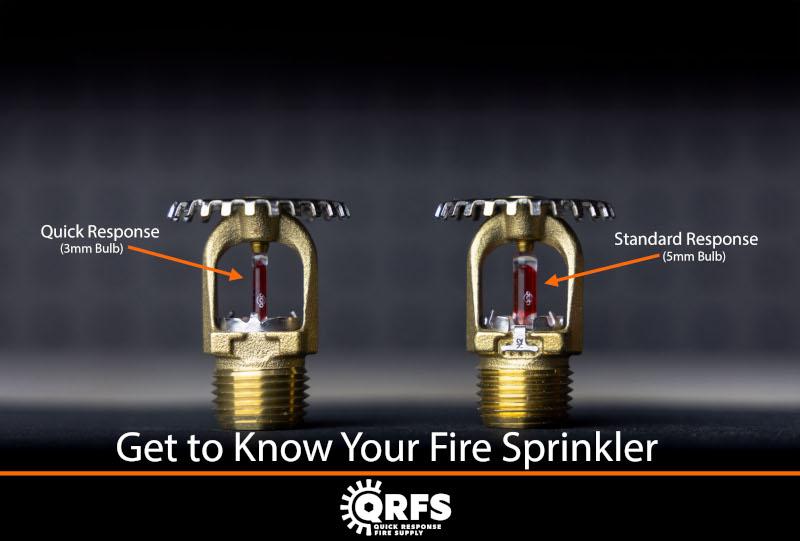
The importance of thermal sensitivity
Specific thermal sensitivities are used in different applications. Fire sprinkler systems are installed in buildings according to the structure’s occupancy classification that assesses:
- How quickly and to the extent stuff in buildings will burn (fuel load)
- The unique risks to people and property
In commercial settings, for example, a light hazard occupancy has less fuel load and risk than other classifications, plus less stringent requirements for how much water is needed to cover an area (design density). Ordinary hazard is a step above that (bigger fuel load and design density), followed by extra hazard. Residential settings also have unique design objectives, including the need to go off fast.
For example, residential sprinklers and sprinklers in light hazard occupancies are fast/quick response because they prioritize life safety. They go off quicker to give people more time to escape before a fire can grow and flashover—the simultaneous ignition of all surfaces in a space—can happen.
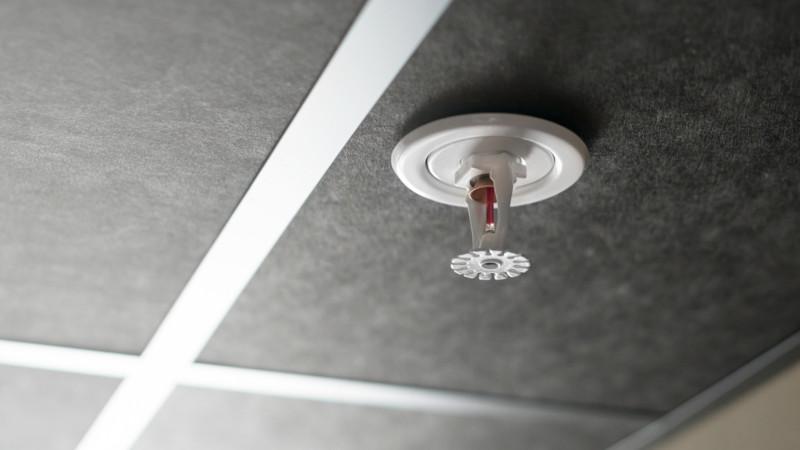
The SIN specifies the physical design of a sprinkler’s thermal element
NFPA 13: Standard for the Installation of Sprinkler Systems (and other documents) requires every sprinkler to have a sprinkler identification number (SIN). This alphanumeric code starts with one or two letters revealing the manufacturer, followed by numbers specifying the model and its essential characteristics.
The SIN typically tells you most things you’d want to know about a sprinkler except its activation temperature and finish, including its response type (some emphasis added):
From the 2022 edition of NFPA 14
6.2.2* Sprinkler Identification.
All sprinklers shall be permanently marked with one or two English uppercase alphabetic characters to identify the manufacturer, immediately followed by three or four numbers, to uniquely identify a sprinkler as to K-factor (orifice size) or orifice shape, deflector characteristic, pressure rating, and thermal sensitivity.
So, given that a single sprinkler and SIN must have a thermal sensitivity (response type)—and this characteristic is determined by the physical design of the heat-sensitive element—how can one head be both quick and standard response?
Here are the two primary scenarios where the thermal sensitivity rating changes:
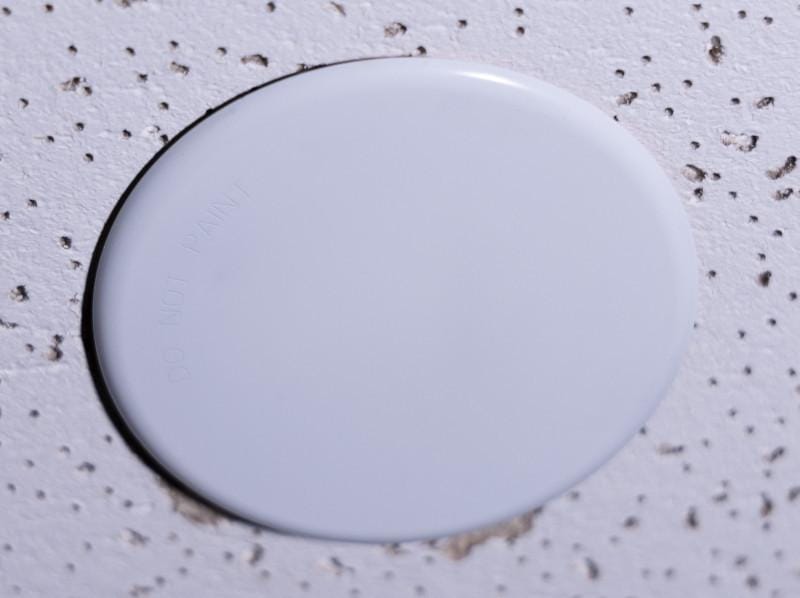
1. Concealed sprinklers: QR vs SR depends on UL Listed or FM Approved
UL Listed and FM Approved are two of the major listing (safety testing and certification) marks for fire sprinklers and other fire protection equipment. NFPA 13 requires all sprinklers to be “listed,” and heads with either (or both) of these stamps of approval meet this criterion, along with others from recognized authorities worldwide.
However, UL and FM (and other bodies) have different testing standards and procedures for sprinklers, and they may categorize identical models and their applications differently. A good summary is that FM Approvals often involve more stringent rules for equipment and systems that need these marks to obtain and maintain insurance coverage.
So, when it comes to concealed sprinklers, a single sprinkler and SIN with a fast/quick response element is:
- UL Listed as quick response
- FM Approved as standard response
Why? The basic explanation is that FM tests don’t regard the thermal sensitivity of concealed sprinklers as fast/quick, given their two-stage activation process: the cover plate must sense heat, activate, and fall away, followed by the sprinkler going off. UL assesses concealed sprinklers a little differently.
So, a concealed sprinkler may be UL Listed as either quick or standard response, while FM regards all concealed heads as standard response—even if they have a fast/quick response thermal element.
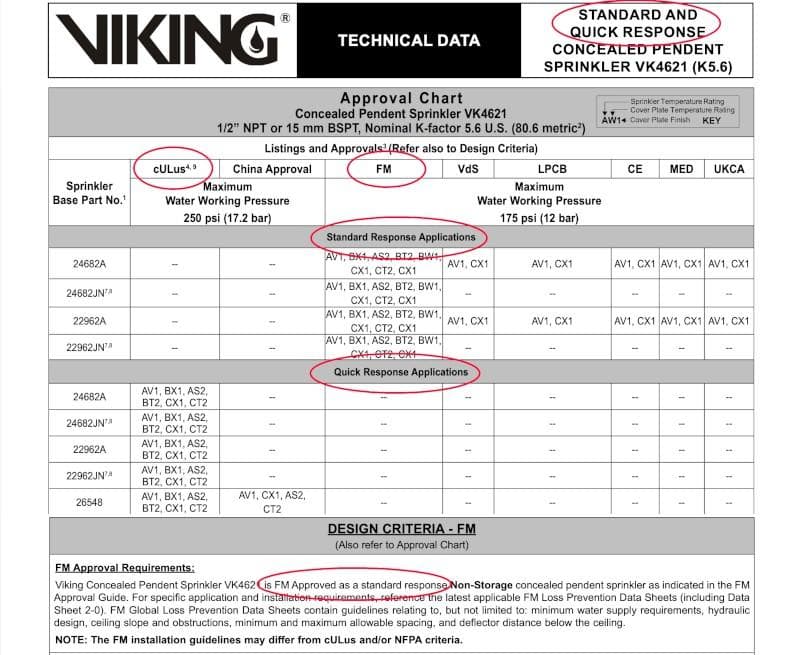
2. Sprinkler distances determine response type—and extended coverage sprinklers are QR and SR
Hydraulically designed fire sprinkler systems must hit a specific design density, which basically means how much water saturates a design area that specific sprinklers protect. This density is measured in gallons per minute per square foot (GPM/ft2) in a specific design area of the structure, and designers must ensure sprinklers hit a minimum density based on square footage and the occupancy classification (hazard level).
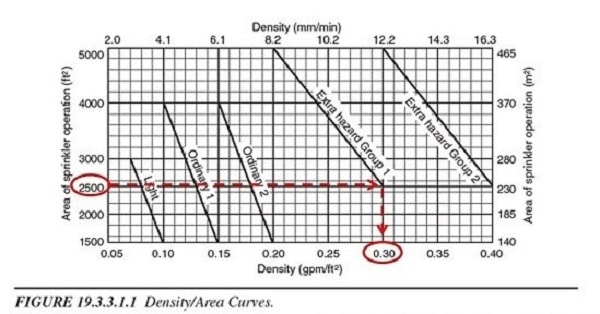
Crucial factors playing into this density are the pressure (PSI) and flow (GPM) available to the sprinklers and the sprinklers’ K-factor (the size of the hole where water comes out). Sprinklers also must be placed close enough together to hit the design density.
Individual sprinklers have maximum coverage areas, typically ranging from 12’ x 12’ to 20’ x 20’, along with maximum spacing at specific pressures and flows. These distances become greater when designers use extended coverage (EC) sprinklers instead of standard coverage (SC) sprinklers.
So, where does response type come in?
Remember, a sprinkler with a fast-response element has a response time index (RTI) of 50 or fewer meters-second1/2. A test that determines this is a “plunge test,” where a lab puts the sprinkler in an oven and sees how fast the bulb breaks or the solder melts.
However, the plunge test is a very controlled assessment in a small environment, so it doesn’t account for some real-world scenarios—especially how far the fire sprinkler is from a heat source that’s setting off other, nearer sprinklers. To account for this, UL conducts a “room heat test” specified in UL 199: Automatic Sprinklers for Fire-Protection Service.
Sprinklers are placed in rooms at various distances from a sand burner “located on the floor in one corner of the room.” Different sprinkler types must go off within specified times, with 99% of the sample meeting this threshold. For example, here are some of the necessary results:
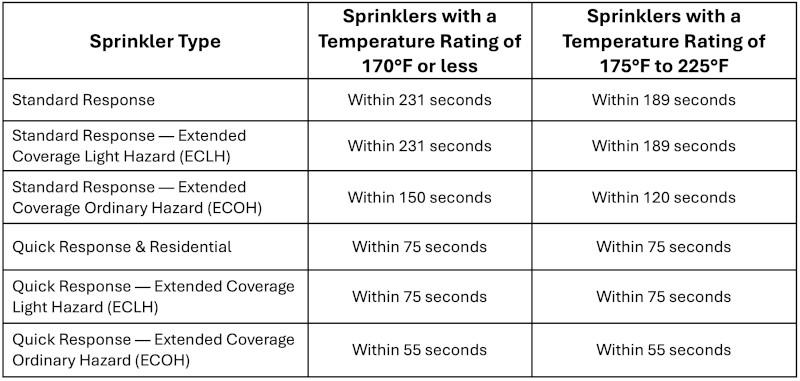
So, when a sprinkler with a fast-response element comes in under its required threshold at a specific distance, it is rated “Quick Response.” When it doesn’t, it is considered “Standard Response” at that distance.
Standard coverage or extended coverage sprinklers could be rated as quick and standard response based on these test results. However, in practice, extended coverage sprinklers that are naturally placed farther away from each other (and a potential fire) are typically the models with this dual designation.
Manufacturers explain when a sprinkler is rated QR or SR in their data sheets. For example, here is a “Sensitivity Rating” table in Tyco’s data sheet for its Series EC-11 and EC-14 extended coverage sprinklers:
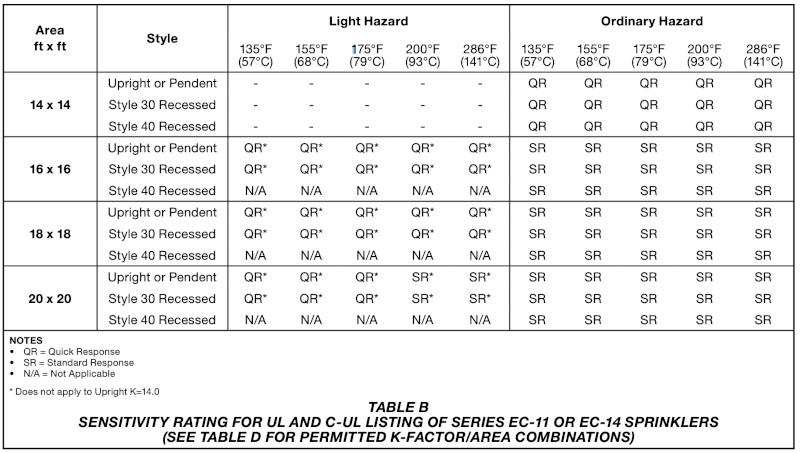
Thermal sensitivity ratings can change based on sprinkler type and application
The next time you see a sprinkler labeled “quick and standard response” or “quick/standard,” you’ll know how it can be both—even though the sprinkler doesn’t physically change or have a different sprinkler identification number. To summarize:
- Heads with standard response thermal elements will never be considered quick response, but quick response sprinklers may be rated standard response in some scenarios.
- The thermal sensitivity rating of concealed sprinklers changes based on whether they must be UL Listed or FM Approved (or have other worldwide marks).
- The further away sprinklers are placed from each other while adhering to maximum coverage areas, the slower they will activate, and the greater the chance of a fast/quick response sprinkler being rated standard response. In practice, this typically applies to extended coverage sprinklers placed farther apart (and in a more challenging occupancy classification).
Finally, remember the crucial rule: always use a sprinkler in its intended application, according to its listings and the details in its data sheet and NFPA standards!
If you need fire sprinklers, QRFS has you covered. We carry sprinklers from Viking, Victaulic, Reliable, Tyco, and Senju, plus compatible cover plates, escutcheons, wrenches, and other tools.
If you have questions or need help placing an order, contact us at 888.361.6662 or support@qrfs.com.
This blog was originally posted at blog.qrfs.com. If this article helped you, check us out at Facebook.com/QuickResponseFireSupply or on Twitter @QuickResponseFS.


